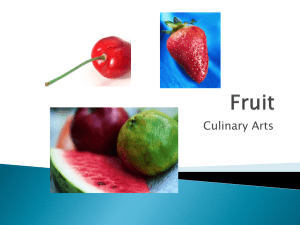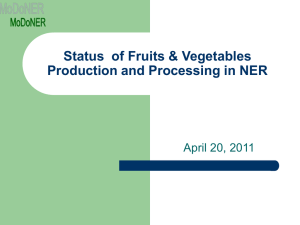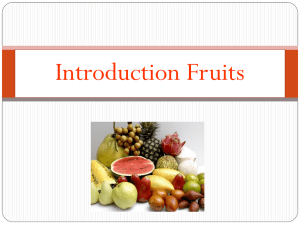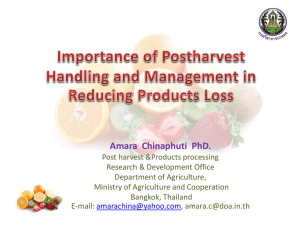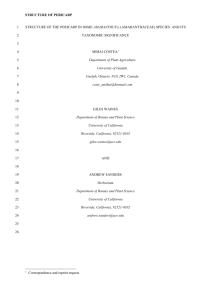Plants and People
advertisement
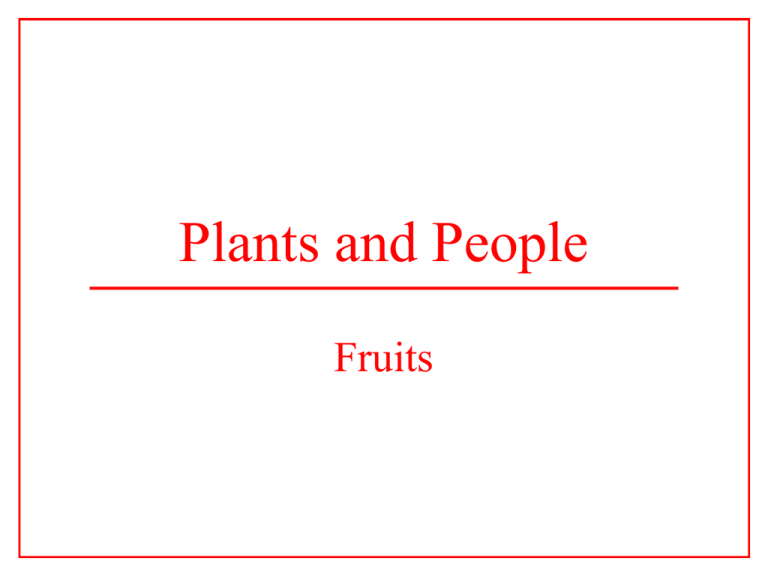
Plants and People Fruits The Carpel The carpel is the basic unit of the gynoecium. Each carpel consists of an ovary connected to a stigma by the style. Within within each carpel are one or more ovules, which will become the seed(s). The area of attachment is called the placenta (pl. = placentae) and the empty space in the chamber is called the locule (pl. = locules). The dividing walls are called the septa. single carpel ovule transverse section locule longitudinal section fused carpels The Single Carpel A gynoecium with only one carpel is termed unicarpellate. A gynoecium of many separate carpels is termed apocarpous. TS LS unicarpellate apocarpous Fused Carpels A gynoecium with many fused carpels is termed syncarpous and the flower is said to have a compound pistil. Evolution of the fused carpel syncarpous Placentation basal placentation: attachment of ovules to the bottom of the ovary. One locule, no septa. Can be found in an apocarpous or syncarpous gynoecium. apical placentation: The attachment of the ovules is at the apex (top) of the ovary. One locule, no septa. Can be found in an apocarpous or syncarpous gynoecium Placentation parietal placentation: ovules are attached to the side walls of the ovary (or extrusions of the wall) such that an ovary usually has one locule and therefore no septa. Can only be found in a syncarpous gynoecium; axile placentation: ovules are attached to an axis derived from the connate margins of the component carpels, such that an ovary is divided into two or more locules by septa. The ovules are borne along the central axis. Can only found in a syncarpous gynoecium. Placentation free or central placentation: attachment of ovules to a freestanding central column in a syncarpous, unilocular ovary (one locule, no septa) marginal placentation: ovules are attached to the folded margins of the carpel, giving the appearance that there is only one elongated placenta on one side of the ovary. Can only be found in a simple pistil. This is conspicuous in legumes. How Many Carpels? Locules? A B C E F G D Simple Fruits A simple fruit is one that is derived from a single ovary, this ovary can be part of an apocarpous, syncarpous or unicarpellate gynoecium. The ovary wall develops into the pericarp, or fruit wall. This may have three layers: the exocarp, mesocarp, and endocarp. The pericarp can develop in various ways, leading to the assortment of simple fruit types. Dry Fruits Dry fruits have the pericarp dry at maturity. Fruits which split open to release the seeds are termed dehiscent. Those that do not split open are called indehiscent. Indehiscent, Dry Fruits Indehiscent, dry fruits do not split at maturity. Subclasses of indehiscent fruits: Achene Grain (caryopsis) Nut Indehiscent, Dry Fruits - Achene Achene - single seeded, thin pericarp, seed coat is separate from ovary wall. Example: sunflower and strawberry “seeds” Indehiscent, Dry Fruits - Grain Grain (caryopsis) - single seeded, pericarp fused with the ovary wall. Example: corn, wheat fused Indehiscent, Dry Fruits - Nut Nut - single seeded, with hard or bony pericarp, wholly or partially surrounded by a husk of bracts. Example: hazelnut, walnut Dehiscent, Dry Fruits Dehiscent fruits are characterized by the splitting of the pericarp to release the seeds. Subclasses of dehiscent fruits: Legume Capsule Dehiscent, Dry Fruits - Legumes Legume - usually dehisces along two sutures; from a simple pistil. Example: beans, peas, soybeans caylx one folded carpel seed/ovule style Unopened Legume Legume Split Open (1 carpel, 2 seams) Dehiscent, Dry Fruits - Capsule Capsule - usually from a compound pistil, usually many seeded. Pericarp opens with pores or slits. Example: okra (which we eat before maturity.) seed septa locule dehisces along locules (loculicidal) okra is a capsule Fleshy Fruits Fleshy fruits are fruits in which all or part of the pericarp is fleshy and swollen at maturity. Types of fleshy fruits: Berry Drupe Hesperidium Pome Pepo Fleshy Fruits - Berry Berry - one to multiple seeds, mesocarp is fleshy, endocarp is soft. Example: grape, tomato Fleshy Fruits - Drupe Drupe - usually one seeded, mesocarp fleshy, endocarp usually hard. Example: peach, plum Fleshy Fruits - Hesperidium Hesperidium - special kind of berry with leathery rind and oil glands dotting the surface. Example: lime, orange Fleshy Fruits - Pepo Pepo fruits are simple fruits that are berrylike with a hard rind; almost always with three carpels and parietal placentation. Examples: melon, squash Fleshy Fruits - Pome Pome fruits are simple fruits that are berrylike with most of the flesh derived from a floral cup and receptacle. Example: Apple, pear (receptacle) Other Fruit Types (Non-Simple) Other fruit types: Multiple Aggregate Accessory Parthenocarpic Non-Simple Fruits - Multiple Multipe fruits are formed by the fusion of fruits of numerous independent flowers. Example: pineapple, fig Non-Simple Fruits - Aggregate Aggregate fruits are those formed from several separate ovaries within a single flower. Examples: raspberry, blackberry Non-Simple Fruits - Accessory Accessory fruits are those where the “fruit” part is derived from something other than ovary tissue. A strawberry is a swollen receptacle and the seeds on the surface are the true fruits, called achenes. Today’s Lab Activities • You need to get information from the prop cards to add to your chart. For each fruit you need to record if it is a monocot or dicot, family and genus/species name, fruit type, origin and carpel number. • For some, carpel number will be given and for others you will need to determine the carpel number yourself by counting the carpels by either counting locules or points of attachments for seeds in an open fruit. • WARNING! If you have a severe allergy to poison ivy, you should not eat mango, pistachios, or cashews unless you know you are not sensitive to them • Other than allergy concerns, you are encouraged to taste things that are new to you by cutting small pieces to eat !! Have fun!

